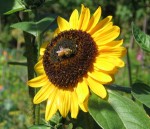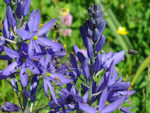Where Have All the Bees Gone?
Clues to the Disappearance of a Vital Pollinator

A honey bee flies toward kale flowers.
The world’s bees are in trouble. In millions of hives around the world, worker bees are suddenly disappearing, causing the colony to die out prematurely. Since 2005, yearly losses in commercial honey beekeeping operations rose from 15 percent of the hives’ bees to as high as 50 percent. Anecdotal evidence from naturalists suggests wild insect pollinators are suffering a similar fate.
This is a planet-sized agricultural disaster because bees and other wild insects pollinate one third of the world’s major food crops, including almonds, apples, avocados, blueberries, broccoli, carrots, cucumbers and onions. It is estimated they fertilize food worth over 200 billion U.S. dollars each season. Bees also produce 1.5 million tons of honey each year. Take away the bees and a large part of the world’s food supply goes with them.
A New Class of Pesticides
Although the stress of modern industrial beekeeping increases bees’ vulnerability to globalized parasites such as Varroa mites and Nosema fungi, many beekeepers, and an increasing number of scientists, believe the trigger for the affliction is a new class of highly toxic and now widely used pesticides: neonicotinoids.

Chemical structure of imidacloprid, a neonicotinoid pesticide.
Introduced in the 1990s, the three main neonicotinoids— imidacloprid, clothianidin, and thiamethoxam— are based on the active ingredient in tobacco. In low concentrations, these pesticides are highly effective nerve poisons against insects. They are less toxic to mammals than earlier types of insecticides, and they are not usually sprayed on like older pesticides, but are applied to the plant’s seed. This means the pesticide becomes integrated into the plant as it grows. Given these features, pesticide manufacturers believed neonicotinoids would be safer than older insecticides such as DDT. Events would soon challenge this hope.
A Disturbing Preview

A honey bee on a sunflower.
In 1994 French growers applied imidacloprid to their sunflower crop for the first time. Within weeks, 400,000 bee colonies that fed on the sunflowers were dead or dying. Despairing beekeepers watched their bees develop uncontrollable shaking and other nerve damage symptoms before they died. In the wake of this catastrophe, the French bee industry began an intense protest to ban the use of neonicotinoids. Five years later, in 1999, the French government finally banned neonicotinoid use on sunflower crops. Despite this and other documented pollinator die-offs, neonicotinoid use accelerated in other countries and they became the most widely used pesticides in the world.
Neonicotinoids Come into Focus
By 2006, as hive losses mounted, the world’s beekeeping communities named the disaster Colony Collapse Disorder (CCD). At about the same time, accumulating scientific studies about neonicotinoids documented the ecological effects on bees that various antiquated and often compromised national pesticide regulatory regimes had missed. These effects included the discovery that these pesticides reached the pollen and nectar of treated plants, and were even more highly toxic to bees when ingested in the course of pollination and feeding. Even when exposure remained vanishingly small, it adversely affected the bees’ navigation and feeding abilities. Moreover, sublethal doses in the parts per billion reduced bee immunity and made the insect and hive more vulnerable to infections. In addition, neonicotinoids remained in the soil much longer than originally anticipated, and so potentially affected successive generations of plants and pollinators. Two recent studies here and here in Science also tell the story.
A Temporary Ban?
Finally in late April 2013, the European Union, alarmed over soaring pollinator die-offs, imposed a two year ban on neonicotinoids. European Environment Agency Executive Director Jacqueline McGlade said: “Based on the body of evidence, we can see that it is absolutely correct to take a precautionary approach and ban these chemicals.”
McGlade went on to say, “France has banned some of these chemicals on sunflower and maize since 2004, and it seems productivity has not been affected – 2007 was France’s best year for yield of these crops for over a decade. Also, any economic analysis should consider the almost immeasurable value of pollination carried out by honey bees and other wild bees. Indeed, continuing to use these chemicals would risk a vital service that underpins European agriculture.”
So far neither Canada nor the United States has followed Europe’s precautionary example. In Canada, where approximately 200 metric tons of neonicotinoids are applied each year to mostly potato, canola, and corn crops, the Pest Management Regulatory Agency is conducting a indeterminate length re-evaluation of neonicotinoid insecticides, while continuing to permit their widespread use.
The Buzz About Pesticides (by Nature Video)
Alternatives & Resources to Help the Bees
Fortunately there are many immediate ways to support honey bees and wild pollinators.
1) Avoid using neonicotinoid-based garden products. To tell if a product contains them, check the label for imidacloprid, dinotefuran, clothianidin, or thiamethoxam.
2) Start a bee garden. Urban gardens have a great effect on bee diversity and can create habitat to nurture native bees.
3) Consider becoming an urban or rural beekeeper.
There are many useful things we can do with our time. Helping the bees is one of the best.
More articles:
 Plant a Bee Attracting Garden
Plant a Bee Attracting Garden
 Plants That Attract Beneficial Insects
Plants That Attract Beneficial Insects
 Farming with Native Plants to Bring Back Pollinators
Farming with Native Plants to Bring Back Pollinators
 Grow a Climate Change Resilient Garden
Grow a Climate Change Resilient Garden
 10 Tips for Year-Round Vegetable Gardens
10 Tips for Year-Round Vegetable Gardens














If you want to attract bees, start by planting Ceanothus (California Lilac). Apart from being a spectacular flowering shrub in full bloom, it attracts so many bees, of all types, it will surprise you. I am a vegetable gardener and need lots of pollinators, so I planted one Ceanothus bush, problem solved. When they know where you are they come back for more.
The bush grows quite large so give it plenty of room and prune it back each year to keep it under control. I am about to move to a new garden, starting from scratch. First thing I will do is find a spot for my new Ceanothus and of cause layout my vegetable garden.
In the last three years friends brought their bee hives to our farm, and during that time we saw their production plummet. Last year there was no honey, in spite of the fact that we planted lots of Buckwheat peas, beans, and Phacelia in a fallow field. Again this year we planted a section in Phacelia, Buckwheat, Peas, Beans, Brassicas, for the Bees, and I have been monitoring the field. To date, I have seen a total of 7 Honey bees in that field. There are many many Bumblebees and other flies, wasps, etc, but virtually no Honeybees. I’m worried.